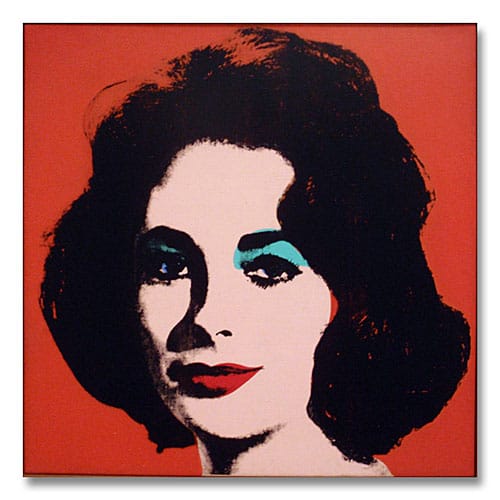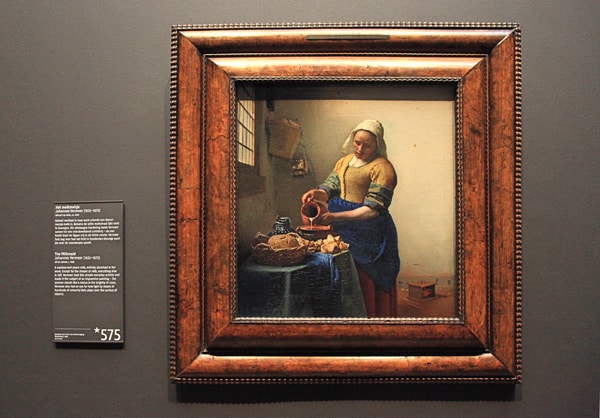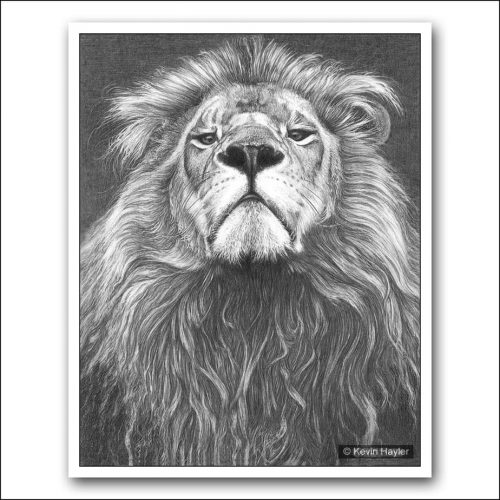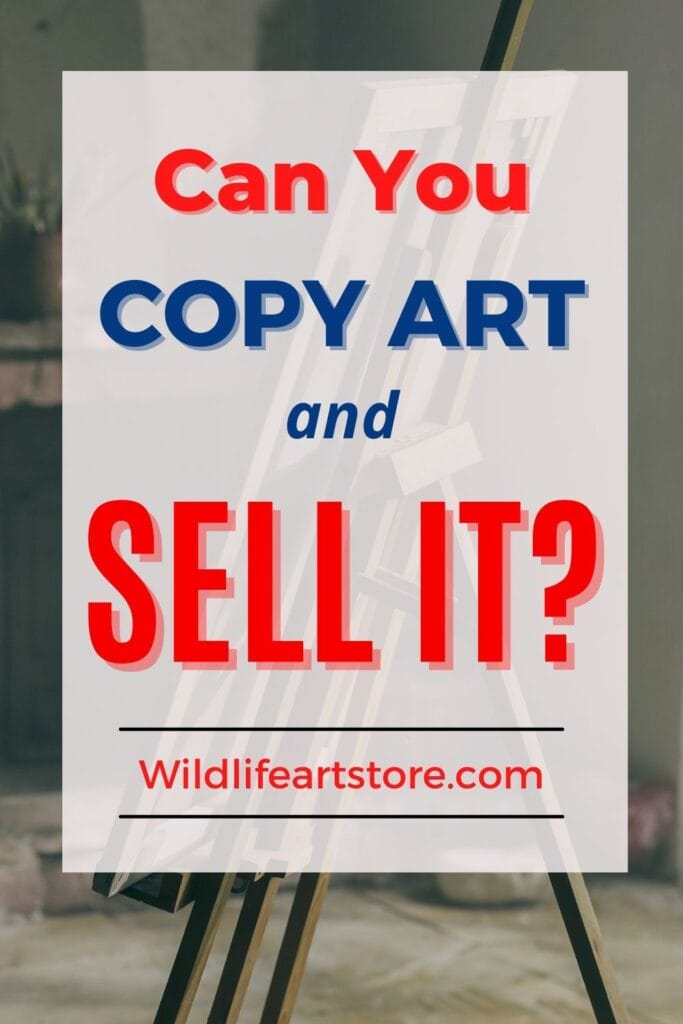How To Find Out The Artist Of A Painting

Can you re-create art and sell a painting of a painting? What almost if the artist is no longer alive? What about copying a picture show online? Even though this sounds like an ethical dilemma, it's also a legal one. This article will cover the problems surrounding copying other people's artwork, likewise as how to protect your own work from being copied by others.
Information technology is legal to copy anything. It is illegal to sell, publicize and publish a copy of an artwork unless you have prior permission from the copyright owner. Information technology is also illegal to publish and sell an artwork that'south substantially like to another original piece of work of art. Copyright lasts for 70 years later the death of the creator at which signal it enters the public domain.
Copying other people'south art and photography is a minefield, so allow's go over the mutual bug one-by-i.
Is it Illegal to Copy Other People'southward Art?
No, it's not illegal, you lot tin copy other people's art. However, it is illegal to nowadays your work equally being original. You should attribute your art every bit having been copied from another person's piece of work of fine art. On no account take you lot got permission to re-create the signature. That's a fraud, plain and unproblematic.
It all becomes murky when the copy is substantially similar to another artist's work. Plagiarism is semi-legal. How do you prove a substantial difference? Where is the dividing line between existence ripped-off and inspiration?
Ultimately only the law courts tin decide the caste that you tin appropriate other people'due south imagery. Andy Warhol got abroad with it and it made him millions.

It also becomes complicated should y'all want to sell your painting of a painting. A single individual sale can be acceptable, that'south an ethical issue, but what if you painted the aforementioned picture over and over again? That's a legal i.
There is a danger that your paintings could undermine the value of the original work you've copied and in such cases, the original artist could theoretically, claim amercement against you.
All imagery is owned by the creator, if they can prove it. That includes photography. You cannot assume that because an image is online that you have any permission to use it.
Having no watermark or copyright symbol does not brand the prototype open up-source. All artists retain the rights to their own work.
Copyrights final for a lifetime plus lxx years unless those rights are sold.
At that place is the provision for copying art under section 107 of the Copyright Human action 1976. Permission is granted for "off-white use" in areas such as educational activity, commentary, criticism, news, research, and so on.
Is Information technology Always Acceptable to Re-create Other People's Art?
There are times when information technology is perfectly advisable to re-create another artist'south work. The obvious reason that springs to mind is when yous are trying to learn how to draw and paint.
How does a student learn if non from their peers and masters? We all learn past copying the artists we honey. I know I certainly did.
For general communication on copying photos read this post.
It is perfectly valid to copy an artwork with the intention of learning. The aforementioned copied painting hung in a gallery, physically or online, ceases to be for pedagogy and is in breach of copyright.
Any artwork over a certain age is in the public domain. That means you must define when the creator died and add together lxx years. Beyond that fourth dimension there are no legal repercussions to worry almost.
Don't brand the mistake of thinking that everything over 70 years erstwhile is fine. The creator's manor still owns the copyright. If a painter died in 1970 the work is protected until 2040.
Y'all can copy an one-time master if you want to, or an old photo for that matter. Plenty of fine art students sit downwardly in galleries and sketch the paintings.

Information technology'due south besides interesting to note that information technology'south non uncommon for artists in the same genre, or from the same time flow, to re-create each other. Artists have always done that.
And different cultures take different views about copying art. Some cultures regard it as more of a violation than others. Anyone traveling through Asia volition realize that copying is not frowned upon with the same degree of concern as it is in the due west.
Can You Copy Fine art and Sell it?
Anyone tin approach the possessor of a slice of art and ask permission to reproduce it. The artist might allow you a sometime-merely usage of their epitome in exchange for money or exposure. They might not have any objections at all. If they aren't professionals themselves they might even be pleased.
Professional artists will want some course of payment and that's normally a royalty from licensing the work for a specific purpose. This is sometimes handled by the creative person themselves or more often by their agents.
If yous are unlucky and the artist has no wish for their piece of work to be used, move on and find some other source.
Problems arise when the intentions are to deceive. If you don't have permission, it'due south stealing. It's not a tribute or an inspiration, and neither is it a compliment. Information technology is taking something from another person, you otherwise could not, or would not, create yourself.
Copying a work with the intention of parodying is also an area that you might have to defend. You lot would accept to argue 'fair use'.
If you are serious about making some money, have a look at my guide and copy the way I do it!

If Y'all Desire to Sell Your Fine art
Check this out!
Psst…it'due south only $12.99!
But What if You Only Copy Part of an Image?
Cherry-picking parts of an image and using them without permission is a gray area. If the re-create forms a substantial office of the original it's a copyright infringement merely if it constitutes a minor part of the original image, so it'south less clear.
Information technology depends on the intention, whether there is any commercial gain from the use and if the 'acquired' department is obviously recognizable.
I depict mostly wildli fe from my own photos and sometimes the paradigm is out of focus, cropped badly or needs adjusting in some way. I have the bulk of the information but I need some missing details.
What am I to practice? Go back into the field or visit a zoo just to take another photo of an animal's foot or ear? Of course not. I discover an image online and use it.
Read this mail service for aid getting started with drawing wild animals.
I practise something like if, on occasion, I need to add some accurate foliage.
I tin't encounter annihilation wrong with very modest alterations done this way.
Can You Copy a Picture show of a Celebrity and Sell It?
No, in general, you can't only draw or pigment a celebrity and sell it. There are two reasons why this might backfire.
A living celebrity is a brand and their image is protected. You lot will need a model release to take any rights. This is non going to be offered for gratis.
Fifty-fifty if you have your own photos, yous cannot use a glory epitome for commercial purposes.
If the celebrity has died and you wish to employ an sometime image, the photographer or their estate, nevertheless has copyright so you will notwithstanding need permission to use it.
The only way you lot might get away with using a celebrity is to change the image beyond recognition from the original photograph. Andy Warhol used that defense. He got abroad with information technology in his lifetime but interestingly, his foundation lost its entreatment against Lynn Goldsmith for stealing her image of Prince.
Can Y'all Copy An Image For a Tattoo?
It is considered bad practise to tattoo another artist'due south work without seeking permission. It is potentially a breach of copyright if the artist can evidence that the tattoo has devalued his/her design and denied them the profits they would otherwise have earned.
Naturally, virtually artists are not in the position to get to law and few would desire to. In essence, it'due south a matter of integrity. Ethically a tattooist should respect the rights of another artist and most do. The rest tin can get abroad with copying work by changing the image sufficiently to claim it every bit their own.
I've met many people over the years who've presented themselves with ane of my images on their bodies, with or without my consent. Personally, I don't actually intendance, it doesn't upset me. I'm more than interested in the quality of the piece of work and I've seen some shockers. At that place are a lot of bad tattooists out there.

The most memorable encounter I had was with a Korean guy who stopped in his tracks when he noticed my portrait of a panthera leo. He rolled upwardly his sleeve and there it was. He'd had it tattooed back in the Far East and by pure coincidence, passed by me, the very artist who created it, one-half a globe abroad. He was amazed and then happy he bought the print as well.
Tin can You Copy and Sell Disney Characters?
You lot cannot copy and sell any Disney images without permission. Disney has been quite strict in the past about its copyrights and trademark.
That goes for Curiosity Comics and Star Wars and every other fantasy creation. You have no right to reproduce the works or use derivatives.
Y'all can't re-create the characters they've drawn but you can use some of the subjects they've used. Many of the well-nigh famous Disney characters are based on works long out of copyright. You are gratuitous to interpret them in your own style or even copy the old illustrations.
For instance:
- Alice in Wonderland
- Peter Pan
- Robin Hood
- The Jungle Book
- Snow White
- To name but a few. The list goes on.
Can You Copy Somone'southward Fine art Manner?
Originality is rare, near artists accept learned their craft past trying to re-create the style of other artists. Merely hither's the thing, yous may get-go out past copying the other creative person's manner, simply very soon your ain style develops.
At that place is no getting around the simple fact that tutors teach their noesis and techniques in their own mode and their students volition follow their instructions. The results will inevitably exist a pastiche.
You can't simply prefer their style. Your efforts would be 2nd best, forever the poor relation, similar a second-charge per unit tribute ring.
You can find your ain art style. It's easier than you remember.
Copying a fashion is only a springboard towards finding your own style of doing things. Nosotros all have our own unique styles and we change directions equally we're influenced by others. Every bit we experiment, nosotros move on.
I remember being defendant of copying another artist when I offset started to sell my drawings. I understood that there were similarities betwixt mine and another well-known artist because we both drew animals only it all the same hurt when all my difficult piece of work was dismissed so casually.
It seems that some critics misfile using the same medium as fashion. What can you lot say? We used different techniques entirely only what if we didn't? What if we had a similar approach, tin can y'all really 'own' a technique? I don't think and so.
Some artists are so unique no 1 can copy their style, only well-nigh people but draw and pigment to the best of their abilities. Copying another artist is, in the end, a fool's errand.
How to Protect Your Artwork From Being Copied
If you're a artistic person, either in business or just for fun, then chances are that at some point someone has copied your work.
How do you stop your images from being stolen? What should you do if someone steals your images?
Watermark each epitome, keep records and provenance. Put your copyright, name, and engagement somewhere on the original artwork, ship a copy to yourself by registered mail, and exit information technology unopened as proof. Do a reverse image search for your art, contact the owner and request that the image is removed, or ask for payment.
1 way to deter casual theft is to disable the right-click 'save as' function. Y'all can do this by calculation code to your site or using a plugin.
I don't become this far. If someone wants to steal the image they'll take a screenshot anyhow, and if someone has a reasonable reason for wanting to save your epitome, it stops them.
Reputable sites will remove stolen images if you can prove their provenance but otherwise, it'south the Wild West out there and there'due south very little y'all tin can do about it.
Most artists are in no position to use the courts. The best you tin can do is threaten legal activeness and that is an empty threat, especially if the theft is foreign.
Do Artists Need to Copyright Their Artwork?
Copyright for artists is a confusing topic. Should I copyright my work? Do I have to annals with the authorities? Will that cease someone from stealing information technology?
Artists are oft told they should copyright their piece of work, but is this true, and if so how? This leads to confusion and sometimes inaction.

I'll try to assistance and brand it simple enough to sympathize.
Works of fine art are automatically assigned copyright the moment they come into existence. You are not required to register your fine art and in that location is no legal obligation to do so.
It is wise withal to keep records. Put the symbol © with your proper name and the year somewhere on the artwork.
The symbol © indicates that this work is copyrighted by its owner, who has exclusive rights to reproduce it, distribute copies of it, create derivative works from it (such every bit translations or abridgments), perform versions of it in public.
Citizens of the US can too register the copyright of their artwork with the Copyright Office to protect confronting infringement.
Registration is non required for protection under US law, although registration does offer additional benefits such as providing prima facie testify that you are the owner of a copyright and can help y'all recover damages in infringement cases. There are fees, currently $35 per single piece.
In that location is no government registration service in the Uk. Instead, you can transport a re-create to yourself using certified mail and/or send another to a solicitor for a safe deposit.
Should You lot Add a Watermark to an Online Artwork?
Many people do not understand the importance of protecting their intellectual property. Information technology is important to protect your work from existence used by others, only it tin can exist difficult to go this idea beyond.
The Internet is full of people who will accept your work without asking permission and use information technology for their own purposes. These people don't care about copyright laws and can cause serious problems for you if they utilize your pictures in an inappropriate manner.
Adding a watermark to all of the images on your website is one solution. This should help remind people that they cannot merely have pictures from the web and apply them as their own.
The best fashion to add a watermark to a file is to use a photo editor. I utilise Photoshop but in that location are free photo editors online. Attempt using a free online website similar PicMonkey, Pixlr, or Canva to add a watermark.
Don't get paranoid and plaster a huge copyright symbol over the prototype. Recollect, if your watermark is too large and obtrusive information technology can detract from the work.

Place it in an unobtrusive place so that people know it's your work without completely taking away from the picture.
I like to add my copyright symbol and name in the bottom right corner of my image. I know it tin be cropped just anyone who is determined to steal your work will do information technology anyway.
I call up of information technology every bit a deterrent for thoughtless theft.
You can also go the other manner and discretely add together your proper noun to the image in tiny secret places. Thieves are looking for the main watermark and won't call up of looking for hidden words within the epitome.
How Large Should The Image File be Online?
Never upload a large file online if you don't want it to be copied.
It's a no-brainer that people will take your work if they see the original on your figurer screen. There are a few ways of circumventing this, but for now, let's focus on file size and how important it is not to upload big files online in guild to avert thieves from copying.
Ideally, your epitome should be no more 1200px wide on the web.
Most art online will autumn below those dimensions. Instagram images, for case, are limited to 1080×1080 pixels. Pinterest posts are larger at 1500L x 1000W pixels but very few people make full their whole pins with standalone images.
Small-scale files can expect great online but when they're printed out, they lose quality. Although at that place is software that tin can enlarge files they tin can't magically restore small Jpg files at 72 DPI to anything similar print quality needed.
You are more likely to have your art stolen and repurposed for the spider web or blatantly plagiarized and ripped off.
I saw i of my images printed on a T-shirt that a guy was wearing in the street. Someone must've scanned one of my prints and thought that by adding something to the prototype it fabricated it their ain. Bloody cheek.
How to Find Your Images Anywhere Online
If you have ever wondered if someone is using your images there is a way to find out
Contrary paradigm search engines volition allow yous to find out what the plant is called and who might be using your image without permission.
Apply reverse image search engines like Google's Reverse Image Search or TinEye to identify the culprits!
Google's Opposite Image Search engine has a very detailed and accurate system for searching specific areas on the internet. TinEye is likewise reliable but it doesn't accept as many images in its database every bit Google.
Go to Google Images and click the camera icon. In the dialog box add a URL or upload an image. Hit 'Search by Image'.
To search using TinEye, you lot demand the URL of a JPEG file or JPG image on the internet. You can also upload an image from your figurer into TinEye's website and then utilize its reverse-image search engine function to identify other images that are identical or very similar in content.
TinEye is besides great because it specifically searches images that have been downloaded from websites so if someone has uploaded your piece of work without permission to a social media site TinEye will be able to notice information technology.
What to Practice When Someone Copies Your Art Online
Then you observe a site using your images without permission what exercise yous about it?
One solution is to practise nothing much. If the site is not using your piece of work to make money or profit, but instead has only used information technology for personal utilise, what's the point? Y'all can always ask them to credit you and add a link, that's fair.
Some other option is to contact them and ask that they have down the image(s). If they comply, then you can consider this a successful resolution of the state of affairs.
You can besides ask for a fee or royalties if they wish to license the image.
If that doesn't work attempt getting in contact with their web hosting company. Most will remove infringing content when they are notified past the copyright holder.
If your art has appeared on a tertiary party platform like a Print-on-Demand company contact them and they will most likely remove the infringing work.
If you are lucky enough to take a big fan base you might be able to rally others to your cause and create so much fuss online that the thief backdowns and slinks back into their cyber serpent pit.
If that doesn't work and you want to pursue legal action. Send a stop and desist letter, or send a DMCA takedown find.
If all else fails, you tin can file a copyright infringement lawsuit on your artwork to recover damages such as lost profits or royalties when it was used without permission.
Let'southward exist real though, are yous e'er going to go that far?
When all is said and washed, is it worth getting stressed and ill health? Of course not, and then allow it get.
Make your own art and learn to sell them. If y'all don't know where to start I can bear witness you how, Step-by-Footstep!

If You Want to Sell Your Art
Bank check this out!
Psst…it's only $12.99!
Tin can You Re-create and Sell Fine art? – Concluding Thoughts
The good news is that there are enough of ways to protect your artwork from being copied.
Yous can use watermarks, copyright tags and reduce the epitome sizes. You lot can find your 'borrowed' images online and almost people will take them downward without a fuss.
Most people aren't rogues but plenty of people are thoughtless. Don't go upset.
I hope this guide has been helpful in showing you some dissimilar ways you tin can go along your piece of work safe online.
Yous will bask these articles too:
- How to Make Prints of Your Art – Printing Fine art Explained in Item
- How to Scale Upwards a Cartoon in 4 Easy Ways and Salve Time
- 120 Cartoon Ideas for Beginners to Enjoy Without Giving Up
- Tracing Art – Is Information technology Good or Bad? When Is Tracing Cheating and Is It Ever OK?
- What Kind of Art Sells Best? All The Secrets Revealed
- What Size of Fine art Sells All-time? Does the Size of Your Art Really Thing?
Pivot IT AND Relieve It

Source: https://www.wildlifeartstore.com/can-you-copy-art/
Posted by: duarterege1964.blogspot.com


0 Response to "How To Find Out The Artist Of A Painting"
Post a Comment